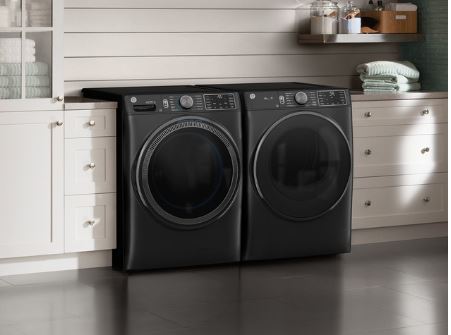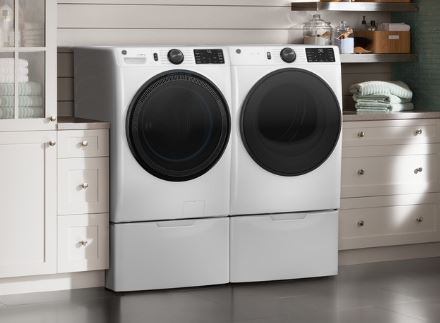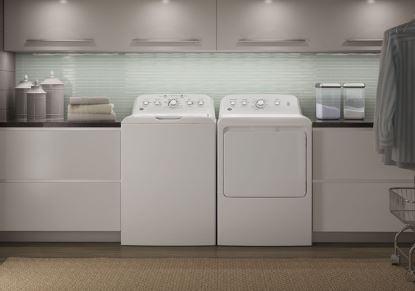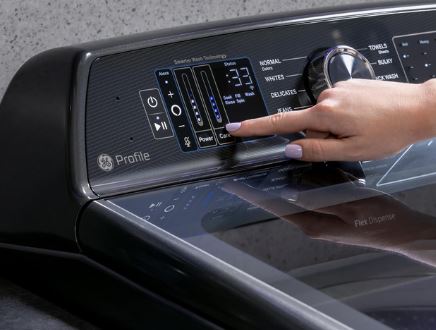While you expect your GE washing machine to start running as soon as it completes the water fill-up process, it’s never guaranteed. Sometimes, a GE washer fills with water then stops, which means you can’t do laundry – at least not until you identify the cause and fix it.
A GE washer often fills with water and then stops due to an error code, paused or wrong cycle, freeze storage, excess suds, an opened lid, stuck tub, drainage obstruction, or component failure.
The aforementioned failed component could be the heating element (or heater), drive belt, water-level switch, motor, or control module. Such components are only fixed by replacing them, and in most cases, you may need to approach an expert for help.
We’ll discuss how all nine issues stop your GE washer from running once it starts filling up with water and what to do to rectify the mess. Moreover, we’ll discuss some other related issues.
Let’s dive in!

In a hurry? Below are the quick fixes to the nine issues often to blame when a GE washer stops after filling with water.
Quick Fixes for a GE Washer That Fills with Water and Then Stops
| – | Likely Cause | Quick Fix |
| 1. | Error Code | Clear the error code – possibly with a reset. |
| 2. | Paused Cycle | Resume the cycle |
| 3. | Wrong Cycle | Override a no-spin, no-drain, or soaking cycle) |
| 4. | Freeze Storage | Give the washer enough time to thaw out. |
| 5. | Excess Suds | Use the detergent in moderation and only use the correct type. |
| 6. | Opened Lid | Ensure the lid latches firmly; if the lid switch is defective, replace it. |
| 7. | Stuck Tub | Remove any foreign objects from the tub. |
| 8. | Drainage Obstruction | Unclog the drain pump, hoses, and water inlet valve. |
| 9. | Component Failure | Replace a defective heating element, drive belt, water-level switch, motor, or control module. |
Why Your GE Washer Fills with Water Then Stops
A GE washing machine doesn’t stop filling unless something is wrong. Similarly, the washer doesn’t stop running after filling unless there’s a fault. In either case, the reason could be any of these 9:
1. Error Code
If there’s an error code on your GE washer, it’s highly likely the reason your washer won’t run after filling up. The error code is trying to tell you something, and so you cannot overlook it. If you do, then the chances are that the washer will refuse to run.
Fix
Try clearing the error code by resetting your washer. You can do that by unplugging it (or flipping off its circuit breaker) for at least 1 minute. If it won’t clear, note it down, check out its meaning online, and try to fix it.
2. Paused Cycle
Sometimes, we accidentally pause the washer without realizing it. That could be the case with you. So, you should check if you unintentionally pressed the pause setting and interfered with the wash cycle.
Fix
If the cycle is paused, resume the wash cycle. That may mean pressing the pause setting again or restarting the washer.
3. Wrong Cycle
Some settings don’t allow the washer to start running immediately after filling it with water. That’s often the case when you choose a no-drain or no-spin setting. So, check if that’s the case.
If it’s not, it could be that your washer is running on a soaking setting, which allows it to draw in water for about 15-30 minutes before it can start agitating or move into the wash cycle. So, check to see if that’s the case.
Fix
Override any no-drain, no-spin, or soak setting if they are active. Ensure you choose the correct setting for your GE washer.

4. Freeze Storage (Below 00C or 320F)
If you store your washer below the freezing range (00C or 320F), it locks the motor and stops running. So, your washer will stop after it starts filling up with water.
Fix
Consider letting your washer thaw out if the air temperature around its storage is below 00C or 320F.
5. Excess Suds
Too many suds indicate either using too much detergent or the wrong type. In either case, the excess suds aren’t good for your washer as they may stop it from running.
If you want to get it right here, use the detergent the manufacturer recommends – preferably HE (high-efficiency) types. More importantly, don’t overuse it.
Fix
If your washer is forming too many suds, reduce the detergent use. While at it, ensure you only use the detergent GE recommends, and if you can’t find it, use HE options.
6. Opened Lid
Is the washer’s lid open? If yes, even if it’s slightly, that’s likely the reason the washer won’t run after filling up. While an opened lid won’t stop the GE washer from filling up, it’s likely to prevent it from running.
Overall, that could be a failure to secure the door firmly, a possible obstruction, or a defective lid switch. You’ve to find out which of the three applies to you.
Fix
Try to firmly latch the lid and remove any visible obstruction (debris or clothing). If the lid still won’t lock firmly, inspect the lid switch with a multimeter and replace it once you determine it lacks electrical continuity.
7. Stuck Tub
If a foreign object gets caught by the drum lock, it’s likely to stop the drum from running. In that case, while the object won’t stop the washer from filling up with water, it’s likely to interfere with its running once it fills up.
Fix
Inspect the tub, especially the drum lock, for visible obstructions and remove any foreign material.
8. Drainage Obstruction
Your washer must drain once it fills up with water. If something interferes with the drainage, the chances are that the washer won’t run.
The drainage obstruction could result from a clogged drain hose, water inlet valve, or drain pump. All those three components should be clog-free for the washer to drain seamlessly.
Fix
Inspect the drain hose, water inlet valve, and drain pump for clogging and clean them. Also, straighten the drain hose if it has any kinks.

9. Component Failure
Lastly, consider that your GE washer might be stopping after filling up due to a failed component. The components to consider in this case include the following:
- Heating element – The heating element auto-turns when the washer begins running and fails when it burns out. Once burnt, the heating element can’t heat the water, and the washer sensors fail to detect water heat changes and thus fail to activate the drum to turn.
- Drive belt – A defective washer belt stops the drum from turning even after the tub fills with water. So, check that!
- Water-level switch – The water-level switch’s job is to monitor and regulate the water filling your washer. Its failure means an interference in the fill-up process, and often, the washer stops running.
- Drive motor – You can expect your washing machine not to run if the drive motor fails. In most cases, the motor doesn’t run but makes a humming noise.
- Control module – Lastly, it could be that the washer’s control module or electronic control board has burnt out. If so, it fails to control the washing machine’s core functions, including the wash and agitation cycles.
Fix
If any of the above components is defective, a replacement is necessary. You may need expert hands to help you in this area. Sometimes, all the washer needs is full servicing, and an expert can help you.
GE Washer Fills with Water Then Stops and Hums
If your GE washer fills with water and then stops and, in the process, produces a humming sound, the chances are that the water inlet valve is malfunctioning. So, you should inspect it for clogging or damage and replace it if that’s the case.
If the issue is not the water inlet valve, it could be a faulty motor, and just like the inlet valve, it also needs a replacement. Other possible explanations for the humming noise include a defective lid switch or timer or poor drainage.
GE Front Load Washer Fills with Water Then Stops
Consider these issues if you have a GE front loader that stops running after starting to fill up with water:
- Incorrect cycle – perhaps a no-spin, no-drain, or soak cycle setting
- Excess suds – a product of detergent overuse
- Paused cycle
- Below-freeze storage (a temperature below 00C)
- An error code
- An unlatched door
- Obstructed tub
- Defective motor, heater, belt, water-level switch or control module
GE Top Load Washer Fills with Water Then Stops
Consider these issues if your GE top loader fills with water and then stops:
- Wrong wash cycle
- Fault code
- Opened lid
- Interrupted or paused cycle
- Too many suds
- Tub obstruction
- Below-freeze washer storage (below 00C)
- Burnt heater
- Defective motor, drive belt, pressure switch, or control module

GE Washer Fills with Water but Won’t Wash
While you expect your GE washer to fill up with water and then wash, sometimes it doesn’t, and that could be a result of a wrong wash cycle setting such as a no-drain or no-spin setting, an error code, a drum overload, or a washer imbalance.
If that’s not so, it’s likely excess suds, poor drainage, or a failed component such as the timer, lid switch, motor, or pressure-level switch.
GE Washing Machine Not Filling Up with Water
Your GE washing machine won’t fill up with water due to one of these reasons:
- An unlatched lid or door
- Disconnected water supply valve
- Faulty water-level control switch
- Clogged inlet screens
- Kinked inlet hoses
- Reduced water pressure
- Timer or control module fault
GE Washer Water Won’t Stop Filling
Your GE washer won’t stop filling up with water for different reasons. It could be that the drain hose height is all wrong (below 30 inches high), the water pressure is insufficient (below 20 psi), or the water-level control switch or water inlet valve is stuck. And if that’s not it, it could result from a defective control board, which needs replacing.
Concluding Thought:
Now you know the nine issues to check when your GE washer fills with water and stops. It starts with a possible fault code, a wrong or interrupted cycle, below-freeze storage, too many suds, an unlatched lid, or obstructed drainage. Once you rule that out, check for a possible failed heating element, drive belt, water-level switch, motor, or control module.
Also Read:
